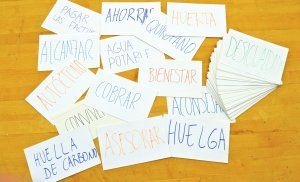4 Activities to Boost Target Language Vocabulary Acquisition
To give his students repeated exposure to relevant vocabulary terms, the author relies on a tried-and-true tool: index cards.
Your content has been saved!
Go to My Saved Content.The wide scope of topics typically covered in intermediate to high-level world language classes requires students to master a lot of meaningful new terms. Given the time constraints students face and the virtually endless number of relevant lexical items, teachers often struggle to integrate vocabulary-developing activities into their daily practice. The problem becomes even more serious when we consider that for vocabulary instruction to be effective it needs to be not just explicit and engaging but frequent—which means running up against those time constraints repeatedly.
Developing a vocabulary deck can be a great way to keep a growing number of terms in learners’ lexical repertoire. A deck is an easy-to-create resource that can be exploited in numerous ways with minimal preparation. The following activities allow teachers to promote students’ vocabulary acquisition naturally by consistently drawing on different language skills—listening, speaking, reading, and writing—at the same time.
Building a Vocabulary Deck
In each print or audio text we cover in my classes, I select several keywords that are important for students to know. I add only five to eight terms at a time—early in a course there may be more new words than that in a single text, but emphasizing too many new terms at once may overwhelm most learners.
The items I select are often associated with formal contexts, and they may appear frequently in the authentic materials students deal with in class, regardless of the topic—terms such as to carry out, achievement, scarce, on average, and findings. Sometimes the terms are specific to a certain field; for these words, I try to involve students by asking them to imagine they are specialists in that field (biology, technology, art, etc.) about to travel to a country where the target language is spoken. They need to select and learn vocabulary that will be useful for them to do their work in the target culture.

I write each word on a four-by-six-inch index card in large enough letters to be read from all the way across the classroom. As the year goes on, the deck grows and is gradually purged of words that my students and I deem too easy. Still, it’s valuable to keep a certain amount of unchallenging terms because they’re reminders of what students know and they help keep all students engaged.
4 Vocabulary Deck Activities
1. Source retelling: I summarize out loud ideas from a source text we’ve covered in class, leaving out keywords that students, working in groups, need to guess. This is a more complex exercise than it may seem: Students need to use their background knowledge and their listening skills as they recall fairly complex content and mobilize their lexical knowledge, and they have to use the target language when conferring in their groups.
Once the correct answer is provided, I hold up the card for everyone to see. Since students work in groups and anyone in the class can call out an answer, the stakes are very low. As an alternative, you can designate an official speaker for each group. At the end of the class, as a review activity, I may ask one or two students to play the role of the teacher, which has the bonus of fostering a cohesive and inclusive learning community.
2. Quickfire rounds: Divided in teams of three or four members, students take turns trying to have their teammates guess as many words from the deck as possible in 30 to 60 seconds by writing a sentence with a blank space where the keyword would go. To ease anxiety, I sometimes let students skip one or two cards. Some groups may be more engaged if I keep score, but this is not always the case.
On occasion I may challenge students to make up original sentences (not definitions), and I push them to venture outside the original context and discover the potential semantic range of each term. For example, if they learn a Spanish word such as nivel (level) in a text that deals with waste management, I might require them to use the word in a sentence that deals with a different topic.
3. Whiteboard descriptions: In this activity, one or two students stand in front of the room while I display for the rest of the class a word from the deck. The group tries to lead the standing student or students to guess the word by writing definitions on their whiteboards.
This activity provides a valuable opportunity to informally assess written accuracy, especially if learners are directed to use only one specific structure or tense. With these constraints, both the student who needs to guess the word and the ones writing definitions receive repeated exposure to a certain language feature, which promotes grammatical awareness.
4. Vocabulary sweep-up: Students lay out all the cards on a table or other large surface and then take 30- to 45-second turns picking them up after using a card’s word in a sentence that shows they understand the meaning of it. They use, or sweep up, as many words as they can during the allotted time. This activity can be done with groups each working on their own or as a competition between groups.
In order to get students to speak spontaneously in this activity, I may call on them randomly. If I do this, I work to reduce students’ anxiety by making it clear that any inaccuracies carry little consequence as long as speakers manage to produce meaningful stretches of language.
Seeing which words are the last to be swept up shows me which vocabulary words may need to be reviewed. For students, it’s often empowering to see how many words they’re able to sweep up in just a few minutes.
